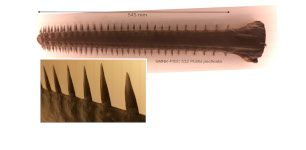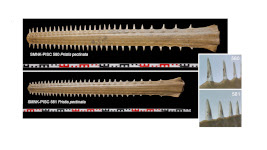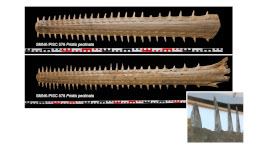Pristis pectinata
Latham, 1794
Smalltooth sawfish
Classification: Elasmobranchii Rhinopristiformes Pristidae
Reference of the original description
An essay on the various species of Sawfish. Transactions of the Linnean Society of London, 2, 273–282
An essay on the various species of Sawfish. Transactions of the Linnean Society of London, 2, 273–282
Image of the original description

Pristis pectinata Latham, 1794

Pristis pectinata Latham, 1794
Synonyms / new combinations and misspellings
Pristis acutirostris, Pristis annandalei, Pristis cf. pectinata, Pristis cf. pectinatus, Pristis granulosa, Pristis leptodon, Pristis megalodon, Pristis occa, Pristis pectinatus, Pristis serra, Pristis woermanni, Pristis (Pristis) pectinatus, Pristobatus occa, Squalus pectinatus
Pristis acutirostris, Pristis annandalei, Pristis cf. pectinata, Pristis cf. pectinatus, Pristis granulosa, Pristis leptodon, Pristis megalodon, Pristis occa, Pristis pectinatus, Pristis serra, Pristis woermanni, Pristis (Pristis) pectinatus, Pristobatus occa, Squalus pectinatus
Types
Pristis pectinata
XXXX: No types known;
Pristis acutirostris
Holotype: MNHN: A-9476;
Pristis granulosa
XXXX: No types known;
Pristis leptodon
Syntype: MNHN: 3485; MNHN: 3486;
Pristis megalodon
Holotype: MNHN: 3484;
Pristis serra
XXXX: No types known;
Pristis woermanni
Holotype: ZMH: 6278;
Pristis pectinata
XXXX: No types known;
Pristis acutirostris
Holotype: MNHN: A-9476;
Pristis granulosa
XXXX: No types known;
Pristis leptodon
Syntype: MNHN: 3485; MNHN: 3486;
Pristis megalodon
Holotype: MNHN: 3484;
Pristis serra
XXXX: No types known;
Pristis woermanni
Holotype: ZMH: 6278;
Description :
Citation: Pristis pectinata Latham, 1794: In: Database of modern sharks, rays and chimaeras, www.shark-references.com, World Wide Web electronic publication, Version 07/2025
Please send your images of "Pristis pectinata" to info@shark-references.com
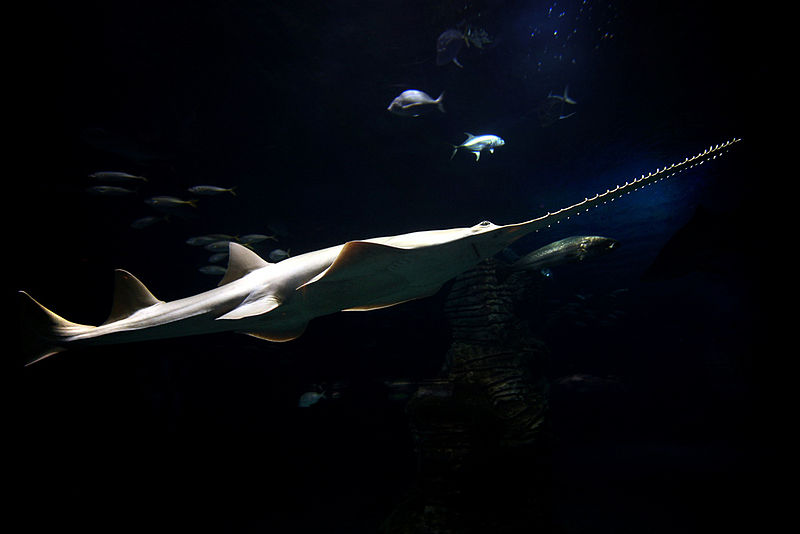
Pristis pectinata Latham, 1794, © Javier Yaya Tur (CAC, S. A.)

Pristis pectinata Latham, 1794, © Javier Yaya Tur (CAC, S. A.)
Common names
 Kammsägefisch,
Kammsägefisch,  Kleinzahn-Sägerochen,
Kleinzahn-Sägerochen,  Sägefisch,
Sägefisch,  Espadachin,
Espadachin,  Espadon,
Espadon,  Pejepeine,
Pejepeine,  Pejepiene,
Pejepiene,  Pejes sierra,
Pejes sierra,  Pez espada,
Pez espada,  Pez peine,
Pez peine,  Pez rastrillo,
Pez rastrillo,  Pez sierra,
Pez sierra,  Pez sierra común,
Pez sierra común,  Pez sierra peine,
Pez sierra peine,  Sierra,
Sierra,  Poisson scie,
Poisson scie,  Poisson-scie,
Poisson-scie,  Poisson-scie tident,
Poisson-scie tident,  Requin-scie,
Requin-scie,  Comb shark,
Comb shark,  Common sawfish,
Common sawfish,  Largetooth sawfish,
Largetooth sawfish,  Saw-fish,
Saw-fish,  Sawfish,
Sawfish,  Small-tooth common sawfish,
Small-tooth common sawfish,  Smalltooth Sawfish,
Smalltooth Sawfish,  Smalltooth sawfish,
Smalltooth sawfish,  Smooth-tooth sawfish,
Smooth-tooth sawfish,  Wide sawfish,
Wide sawfish,  Pesce sega,
Pesce sega,  Pesce sega denti piccoli,
Pesce sega denti piccoli,  Araguaguai,
Araguaguai,  Araguaguá,
Araguaguá,  Cação serra,
Cação serra,  Espadarte-serra,
Espadarte-serra,  Peixe-serra,
Peixe-serra,  Tubarão-serra,
Tubarão-serra,  Tubarão-serra candú
Tubarão-serra candú
 Kammsägefisch,
Kammsägefisch,  Kleinzahn-Sägerochen,
Kleinzahn-Sägerochen,  Sägefisch,
Sägefisch,  Espadachin,
Espadachin,  Espadon,
Espadon,  Pejepeine,
Pejepeine,  Pejepiene,
Pejepiene,  Pejes sierra,
Pejes sierra,  Pez espada,
Pez espada,  Pez peine,
Pez peine,  Pez rastrillo,
Pez rastrillo,  Pez sierra,
Pez sierra,  Pez sierra común,
Pez sierra común,  Pez sierra peine,
Pez sierra peine,  Sierra,
Sierra,  Poisson scie,
Poisson scie,  Poisson-scie,
Poisson-scie,  Poisson-scie tident,
Poisson-scie tident,  Requin-scie,
Requin-scie,  Comb shark,
Comb shark,  Common sawfish,
Common sawfish,  Largetooth sawfish,
Largetooth sawfish,  Saw-fish,
Saw-fish,  Sawfish,
Sawfish,  Small-tooth common sawfish,
Small-tooth common sawfish,  Smalltooth Sawfish,
Smalltooth Sawfish,  Smalltooth sawfish,
Smalltooth sawfish,  Smooth-tooth sawfish,
Smooth-tooth sawfish,  Wide sawfish,
Wide sawfish,  Pesce sega,
Pesce sega,  Pesce sega denti piccoli,
Pesce sega denti piccoli,  Araguaguai,
Araguaguai,  Araguaguá,
Araguaguá,  Cação serra,
Cação serra,  Espadarte-serra,
Espadarte-serra,  Peixe-serra,
Peixe-serra,  Tubarão-serra,
Tubarão-serra,  Tubarão-serra candú
Tubarão-serra candú
Short Description
Pristis pectinata is easily separable from Pristis perotteti by the following characters: its first dorsal fin originates about over the origin of its pelvic fins vs. considerably in front of origin of pelvic fins in P. perotteti; its caudal fin is much shorter, but broader relative to the length of the fin, with lower lobe only faintly indicated; its rostral teeth are numerous, 23 or more on each side vs. not more than 20 in P. perotteti; its saw is relatively somewhat shorter; its second dorsal fin has the posterior margin much less deeply concave; and its pectoral fins are smaller [199] (Ref. 81624). Pristis pectinata agrees with Pristis pristis in the shape of its caudal fin and in the position of the first dorsal fin relative to the pelvic fins, but it can be separated from P. pristis by its more numerous rostral teeth, 23 or more on each side vs. less than 20 [199] (Ref. 81624).
Pristis pectinata is easily separable from Pristis perotteti by the following characters: its first dorsal fin originates about over the origin of its pelvic fins vs. considerably in front of origin of pelvic fins in P. perotteti; its caudal fin is much shorter, but broader relative to the length of the fin, with lower lobe only faintly indicated; its rostral teeth are numerous, 23 or more on each side vs. not more than 20 in P. perotteti; its saw is relatively somewhat shorter; its second dorsal fin has the posterior margin much less deeply concave; and its pectoral fins are smaller [199] (Ref. 81624). Pristis pectinata agrees with Pristis pristis in the shape of its caudal fin and in the position of the first dorsal fin relative to the pelvic fins, but it can be separated from P. pristis by its more numerous rostral teeth, 23 or more on each side vs. less than 20 [199] (Ref. 81624).
Distribution
Circumglobal. Western Atlantic: North Carolina (USA), Bermuda and northern Gulf of Mexico [17658] to Argentina [5839]. Caribbean, rare in Bermuda [17659]. Eastern Atlantic: Gibraltar to Namibia; possibly in the Mediterranean Sea [541]. Indo-West Pacific: Red Sea and East Africa to the Philippines [541]. Possibly occurring in the eastern Pacific [541]. Source: www.gbif.org
Circumglobal. Western Atlantic: North Carolina (USA), Bermuda and northern Gulf of Mexico [17658] to Argentina [5839]. Caribbean, rare in Bermuda [17659]. Eastern Atlantic: Gibraltar to Namibia; possibly in the Mediterranean Sea [541]. Indo-West Pacific: Red Sea and East Africa to the Philippines [541]. Possibly occurring in the eastern Pacific [541]. Source: www.gbif.org
Human uses
fisheries: minor commercial; gamefish: yes; price category: medium; price reliability: very questionable: based on ex-vessel price for species in this family
fisheries: minor commercial; gamefish: yes; price category: medium; price reliability: very questionable: based on ex-vessel price for species in this family
Biology
Ovoviviparous, with gravid females containing about 15-20 embryos [7182]. Embryos feed solely on yolk [733]. Gives birth in shallow bays and estuaries [1658]. Size at birth 61 cm [1658].
Ovoviviparous, with gravid females containing about 15-20 embryos [7182]. Embryos feed solely on yolk [733]. Gives birth in shallow bays and estuaries [1658]. Size at birth 61 cm [1658].
Size / Weight / Age
TL (max): 554 cm, reports to 760 cm TL are likely exaggerations, TL (born): ~60 cm, TL (mature): male: unclear, record of TL 371 cm was mature; female: unclear, record of TL 415 cm was mature [24867]; max. published weight: 350.0 kg [7176]
TL (max): 554 cm, reports to 760 cm TL are likely exaggerations, TL (born): ~60 cm, TL (mature): male: unclear, record of TL 371 cm was mature; female: unclear, record of TL 415 cm was mature [24867]; max. published weight: 350.0 kg [7176]
Remarks
shark-references Species-ID=5076; CITES: (see: Protected Species for more details) Convention on International Trade in Endangered Speciesof Wild Fauna and Flora annex: I; Council Regulation 2017/160 annex: A
shark-references Species-ID=5076; CITES: (see: Protected Species for more details) Convention on International Trade in Endangered Speciesof Wild Fauna and Flora annex: I; Council Regulation 2017/160 annex: A
Parasites (arranged by Jürgen Pollerspöck)
Monogenea
Trematoda
Isopoda
Monogenea
- Dermophthirioides pristidis Cheung & Nigrelli, 1983 [7260]
- Mycteronastes caalusi Kritsky, Bullard, Bakenhaster, Scharer & Poulakis, 2017 [25877]
- Neoheterocotyle inpristis (Hargis, 1955) [7260] [17439]
Trematoda
- Achorovermis testisinuosus Warren & Bullard, 2020 [28589]
Isopoda
- Nerocila acuminata Schioedte & Meinert, 1883 [23898]








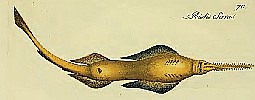
.jpg)
.jpg)
.jpg)
.jpg)
.jpg)

